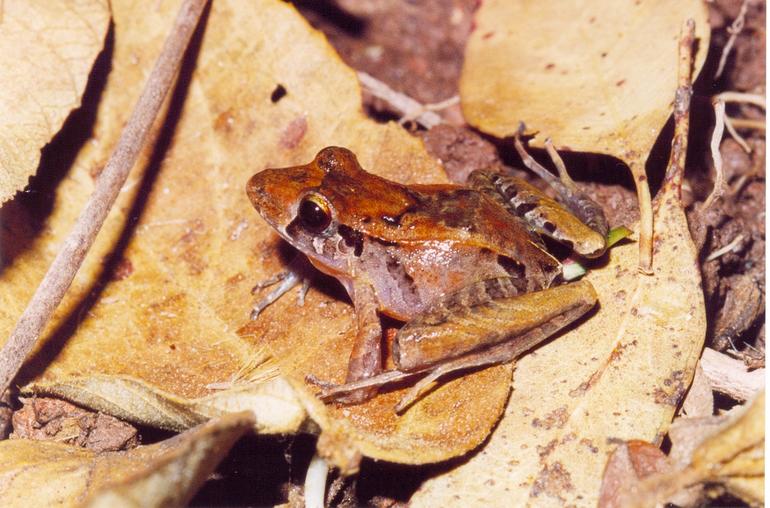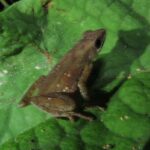- Introduction: A Hidden Jewel of the Atlantic Forest
- Taxonomy and Classification: Placing Ischnocnema izecksohni into Context
- Natural Habitat: The Arboreal Symphony of Brazil's Atlantic Forest
- Physical Characteristics: A Camouflaged Masterpiece
- Behavior and Life Cycle: Secrets from the Forest's Floor
- Ecological Role: Amphibious Guardians of Biodiversity
- Threats and Conservation Status: A Struggle for Survival
- Cultural and Scientific Significance: Celebrating Nature's Wonders
- Conclusion: Advocating for a Future Shared with Ischnocnema izecksohni
Introduction: A Hidden Jewel of the Atlantic Forest#
Deep within the dense, lush foliage of Brazil’s Atlantic Forest, echoes the subtle song of a tiny, elusive amphibian—the elegantly named Ischnocnema izecksohni. Often overlooked by researchers and casual nature lovers alike, this remarkable frog harbors intriguing secrets that continue to captivate scientists and naturalists. Discovered only relatively recently, it bears the name of esteemed Brazilian herpetologist Eugenio Izecksohn, celebrated for unraveling the mysteries of Brazilian amphibians.
Unlike many amphibians known broadly for their aquatic dependencies, Ischnocnema izecksohni stands apart due to its terrestrial life cycle, laying eggs that hatch directly into miniature frogs, completely bypassing the aquatic tadpole stage. This extraordinary reproductive trait makes this species especially fascinating within evolutionary biology, signaling its highly specialized adaptation to its forested habitat.
Taxonomy and Classification: Placing Ischnocnema izecksohni into Context#
Belonging to the family Brachycephalidae, Ischnocnema izecksohni shares lineage with many small, terrestrial frogs, notably known for direct embryonic development—a trait allowing them to thrive independently of standing water. The genus name “Ischnocnema” translates roughly to “thin-legged,” aptly describing distinctive, slender limbs common among its members, enabling agile navigation of complex habitats.
Described scientifically in 2008, the species pays tribute to Eugênio Izecksohn, a legendary Brazilian herpetologist renowned for identifying and describing numerous amphibians indigenous to South America. His influential research laid foundational understanding for this richly diverse family of amphibians.
Natural Habitat: The Arboreal Symphony of Brazil’s Atlantic Forest#
The spectacular Atlantic Forest of Brazil serves as the exclusive home to Ischnocnema izecksohni. Spanning humid montane regions, especially in the state of Rio de Janeiro, the species favors pristine, moist, broadleaf forests at moderate elevations ranging approximately between 500 to 1000 meters above sea level.
Navigating through leaf-littered forest floors and low-lying shrubs, this frog demonstrates a sleek terrestrial prowess. Its habitat teems with life—from towering trees draped in epiphytes and orchids to moss-covered rocks sheltering a universe of insects, spiders, and arthropods. Within this vibrant complexity, I. izecksohni fulfills a critical ecological niche as both predator and prey, seamlessly integrated within the delicately balanced ecosystem of the Atlantic Forest.
Its terrestrial reproductive strategy allows it to flourish disconnected from permanent water sources, conferring resilience in an ever-changing environment. Yet, their dependence on intact forest habitats confines them to undisturbed areas, making these frogs sensitive sentinels indicating forest health.
Physical Characteristics: A Camouflaged Masterpiece#
Delicately proportioned and modestly sized, with adult individuals typically measuring between 21 and 27 millimeters, Ischnocnema izecksohni presents the archetypal form of a tiny yet highly adaptive rainforest dweller. Though diminutive, its intricate appearance immediately captivates observers.
The species exhibits cryptic coloration, a complex tapestry woven from earthy hues—rich browns, mottled greys, subtle greens, and hints of burnt amber. These colorations blend impeccably into the complex mosaic of rotting leaves, bark, and forest moss, offering near-perfect concealment from potential predators and unsuspecting prey. Their granular skin texture, further enhanced with subtle bumps and ridges, mimics the uneven surfaces of their surroundings, amplifying their camouflage perfection.
Large, vigilant eyes positioned on their rounded heads provide excellent spatial awareness, essential in the dense terrestrial environment. Minute differentiation among individual patterns aids in species identification and serves as an exciting challenge for naturalists and researchers working diligently to uncover the mysteries of this elusive amphibian.
Behavior and Life Cycle: Secrets from the Forest’s Floor#
Diet and Hunting Techniques#
Feeding primarily at night, Ischnocnema izecksohni embarks on stealthy nocturnal raids across the forest floor in pursuit of small arthropods, including various small insects, mites, and spiders. Employing patient ambush tactics and swift predatory leaps, they adeptly seize their unsuspecting quarry, playing a subtle but critical role in invertebrate population control.
Unique Reproduction: Skipping the Tadpole Stage#
Perhaps the most astonishing aspect of Ischnocnema izecksohni lies in its direct reproductive strategy. Rather than laying eggs in water, female frogs deposit clutches of eggs in moist, protected microhabitats, such as inside curled tree leaves or hidden among damp leaf litter. Here, embryos undergo uninterrupted terrestrial development until fully formed miniature frogs emerge, skipping aquatic stages altogether. This evolutionary adaptation significantly reduces dependency on water, allowing the species extraordinary habitat flexibility yet vulnerability to environmental changes affecting humidity levels.
Ecological Role: Amphibious Guardians of Biodiversity#
Amphibians such as I. izecksohni function as ecological indicators, their presence signaling high-quality habitats and reflecting the health and stability of ecosystems. Their insectivorous behaviors control pest populations, helping maintain ecological balance essential to forest integrity.
Simultaneously, these frogs act as prey sources for various predators, including birds, snakes, and larger mammals, forming an essential link in the intricate food web sustaining the vibrant biodiversity of the Atlantic Forest. Their gradual disappearance, therefore, indicates deeper ecological disruptions often overlooked until irreparable harm has occurred.
Threats and Conservation Status: A Struggle for Survival#
Habitat Loss and Fragmentation#
Unfortunately, the Atlantic Forest faces severe habitat degradation due to alarming rates of deforestation driven primarily by agriculture expansion, urbanization, and infrastructure development. Fragmented habitats isolate populations, while loss of vegetation cover compromises microhabitats essential for this species’ unique terrestrial reproduction, threatening their survival.
Climate Change and Disease#
Global climate shifts compound these risks by altering precipitation patterns and raising average temperatures, potentially drying out critical microhabitats and reducing breeding success. Additionally, emerging infectious amphibian diseases, such as the chytrid fungus (Batrachochytrium dendrobatidis), pose real, ever-increasing threats to amphibian populations globally.
Conservation Efforts and Status#
As of current IUCN Red List assessments, Ischnocnema izecksohni is classified as Data Deficient, highlighting the lack of comprehensive knowledge on population trends and detailed distribution. Conservation steps include advocating for protected area expansions, ecological restoration projects, detailed scientific monitoring, and encouraging responsible ecotourism promoting wider public awareness and involvement.
Cultural and Scientific Significance: Celebrating Nature’s Wonders#
Though scarcely known in popular culture, species like I. izecksohni emphasize the profound biodiversity hidden within Brazil’s national treasure, the Atlantic Forest. Scientifically, frogs representing direct terrestrial development provide fields of evolutionary biology, physiology, and ecology with rich avenues for research, offering insights into adaptive strategies necessary for terrestrial survival.
Conclusion: Advocating for a Future Shared with Ischnocnema izecksohni#
Ischnocnema izecksohni encapsulates the alluring mystery and delicate complexity inherent in the Atlantic Forest’s biodiversity tapestry. Its terrestrial adaptations and secretive behaviors remind us that even small, seemingly inconspicuous creatures play disproportionately essential roles in sustaining ecological balance.
Understanding, protecting, and actively conserving species like Ischnocnema izecksohni underscores humanity’s shared responsibility. By supporting habitat conservation initiatives and fostering wider awareness, each of us holds the power to contribute meaningfully to protecting the extraordinary wonders that our natural world graciously reveals, one enigmatic species at a time.








